Woolworths' Organizational Culture: Analysis and Recommendations
VerifiedAdded on 2023/04/23
|8
|1543
|122
Report
AI Summary
This report examines the organizational culture challenges faced by Woolworths, focusing on issues like employee exploitation and ineffective leadership. The analysis draws upon organizational culture theories, particularly the hierarchical model, to understand the complexities within Woolworths' structure. The report identifies a disconnect between the intended function of hierarchical culture and its actual implementation, leading to communication breakdowns and employee dissatisfaction. Furthermore, the report critiques Woolworths' leadership approach, advocating for a more employee-oriented style to foster a positive organizational culture. Recommendations include implementing change management from the top down, adopting a clan culture to promote collaboration and communication, and increasing employee representation in decision-making processes. The report concludes that addressing these issues is crucial for Woolworths to improve employee relations and overall organizational effectiveness, and that Desklib provides access to similar resources for students.
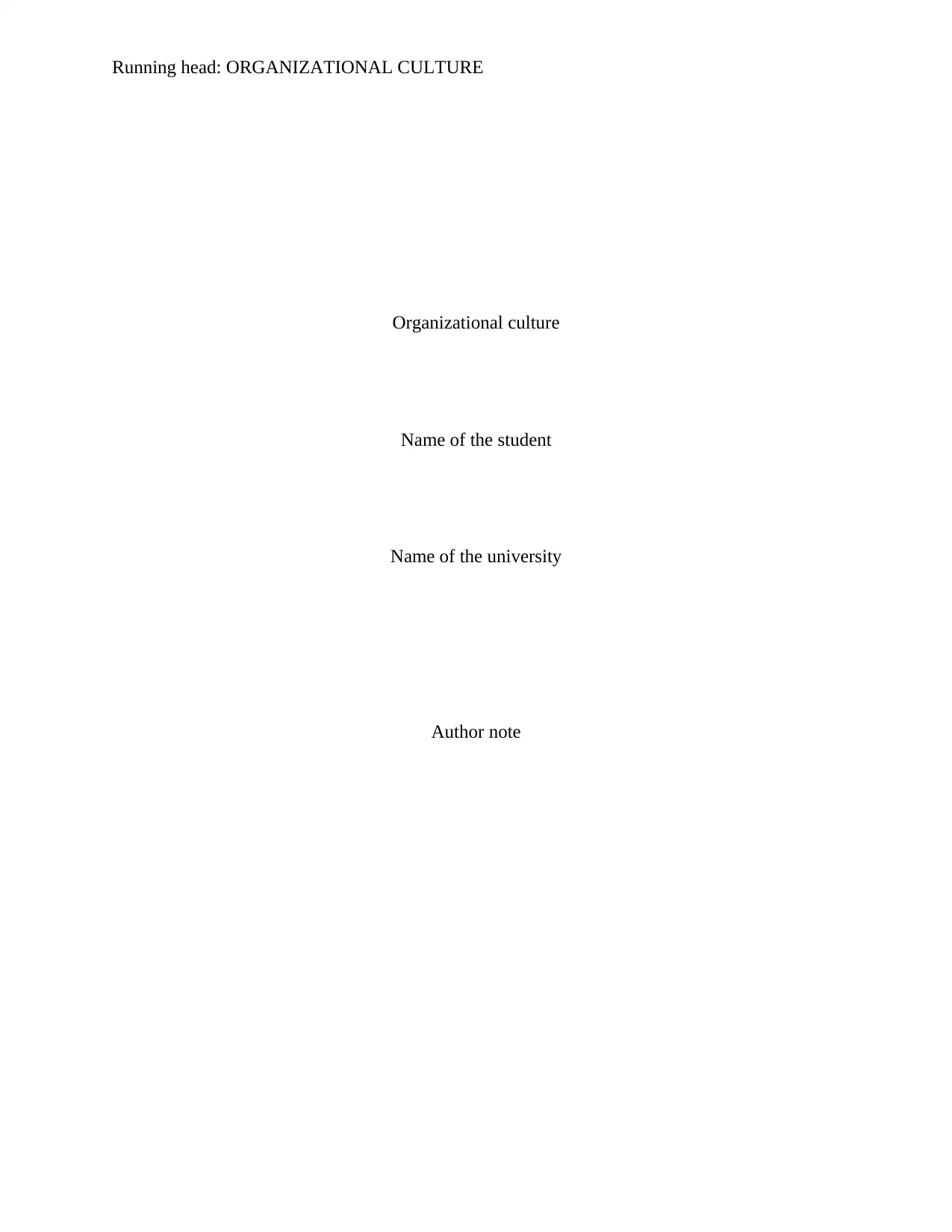
Running head: ORGANIZATIONAL CULTURE
Organizational culture
Name of the student
Name of the university
Author note
Organizational culture
Name of the student
Name of the university
Author note
Paraphrase This Document
Need a fresh take? Get an instant paraphrase of this document with our AI Paraphraser
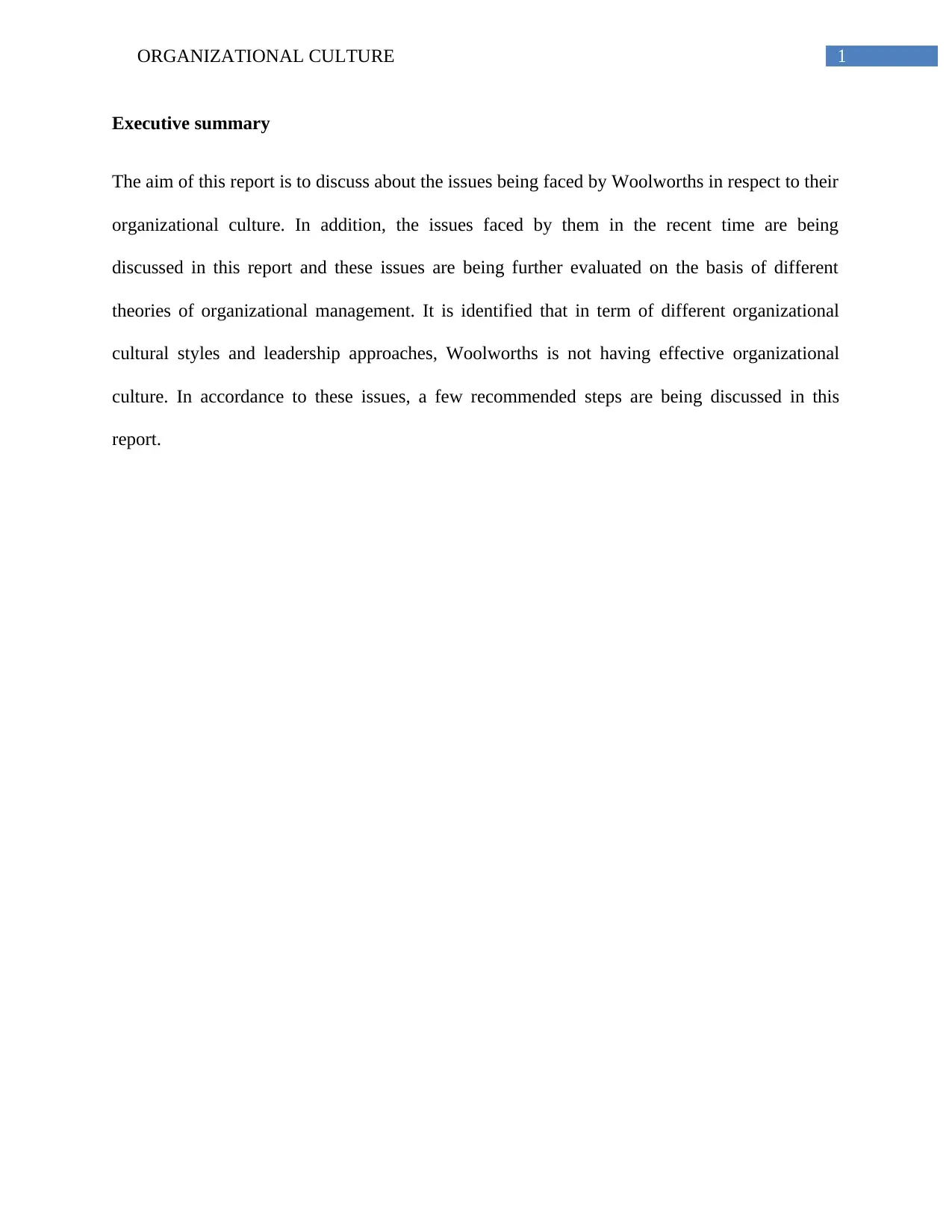
1ORGANIZATIONAL CULTURE
Executive summary
The aim of this report is to discuss about the issues being faced by Woolworths in respect to their
organizational culture. In addition, the issues faced by them in the recent time are being
discussed in this report and these issues are being further evaluated on the basis of different
theories of organizational management. It is identified that in term of different organizational
cultural styles and leadership approaches, Woolworths is not having effective organizational
culture. In accordance to these issues, a few recommended steps are being discussed in this
report.
Executive summary
The aim of this report is to discuss about the issues being faced by Woolworths in respect to their
organizational culture. In addition, the issues faced by them in the recent time are being
discussed in this report and these issues are being further evaluated on the basis of different
theories of organizational management. It is identified that in term of different organizational
cultural styles and leadership approaches, Woolworths is not having effective organizational
culture. In accordance to these issues, a few recommended steps are being discussed in this
report.
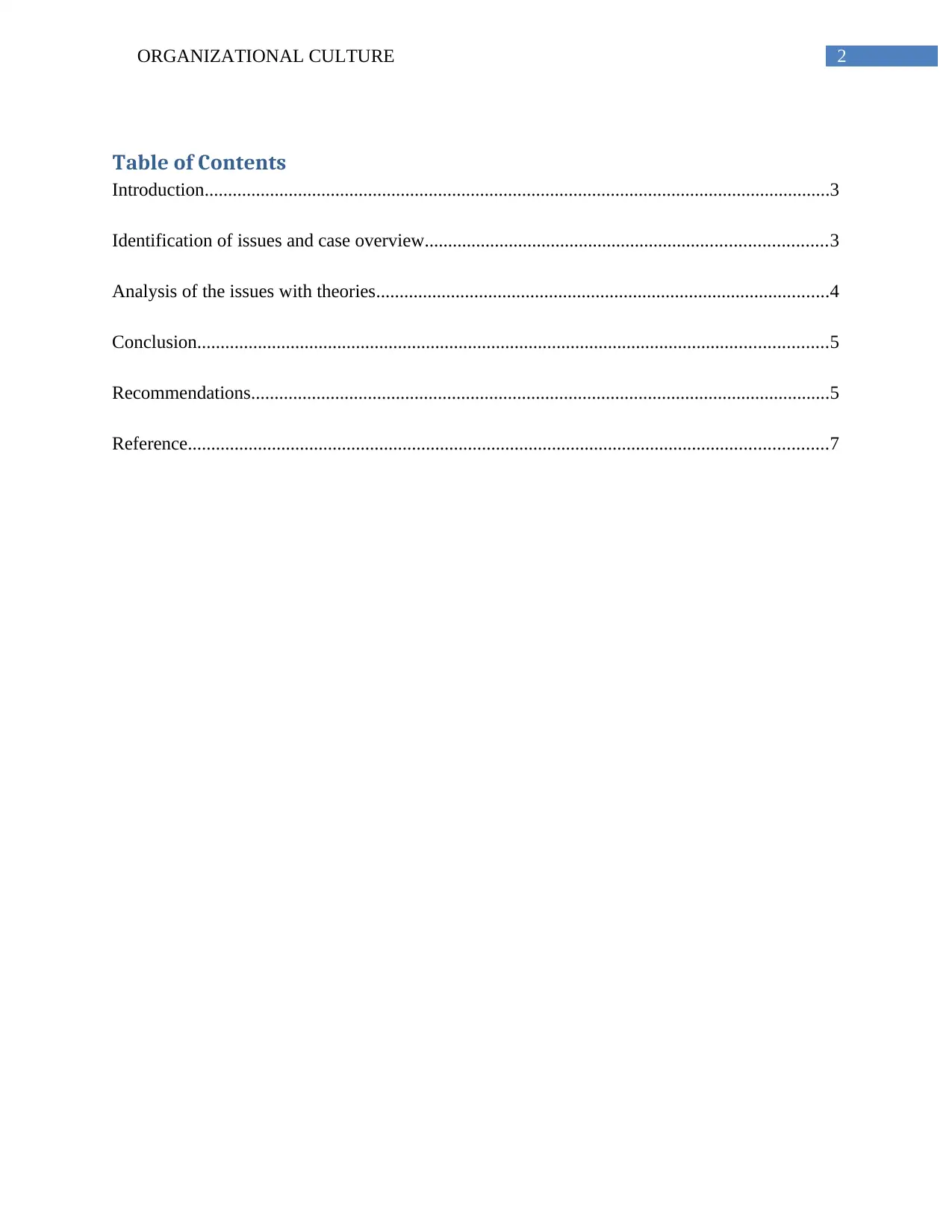
2ORGANIZATIONAL CULTURE
Table of Contents
Introduction......................................................................................................................................3
Identification of issues and case overview......................................................................................3
Analysis of the issues with theories.................................................................................................4
Conclusion.......................................................................................................................................5
Recommendations............................................................................................................................5
Reference.........................................................................................................................................7
Table of Contents
Introduction......................................................................................................................................3
Identification of issues and case overview......................................................................................3
Analysis of the issues with theories.................................................................................................4
Conclusion.......................................................................................................................................5
Recommendations............................................................................................................................5
Reference.........................................................................................................................................7
⊘ This is a preview!⊘
Do you want full access?
Subscribe today to unlock all pages.

Trusted by 1+ million students worldwide
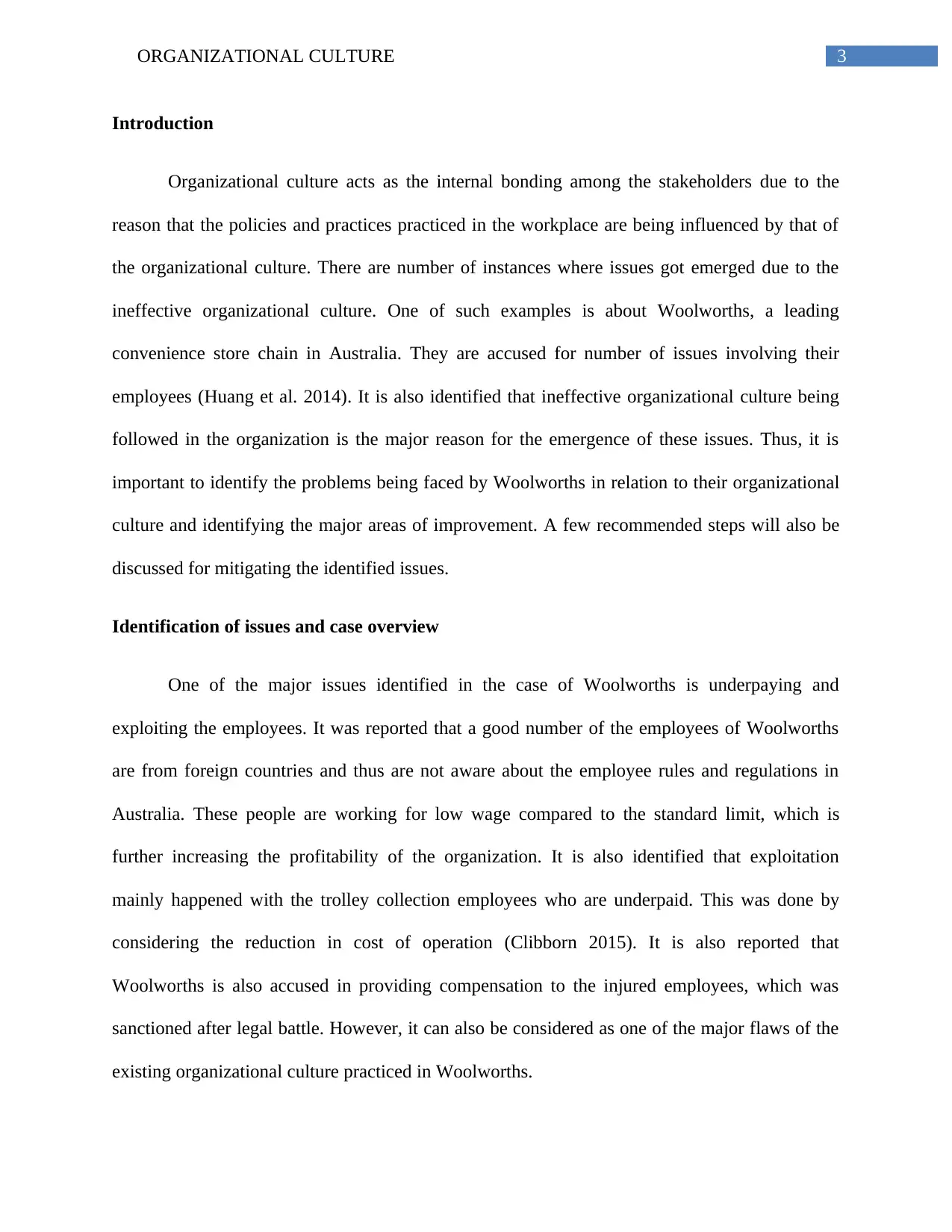
3ORGANIZATIONAL CULTURE
Introduction
Organizational culture acts as the internal bonding among the stakeholders due to the
reason that the policies and practices practiced in the workplace are being influenced by that of
the organizational culture. There are number of instances where issues got emerged due to the
ineffective organizational culture. One of such examples is about Woolworths, a leading
convenience store chain in Australia. They are accused for number of issues involving their
employees (Huang et al. 2014). It is also identified that ineffective organizational culture being
followed in the organization is the major reason for the emergence of these issues. Thus, it is
important to identify the problems being faced by Woolworths in relation to their organizational
culture and identifying the major areas of improvement. A few recommended steps will also be
discussed for mitigating the identified issues.
Identification of issues and case overview
One of the major issues identified in the case of Woolworths is underpaying and
exploiting the employees. It was reported that a good number of the employees of Woolworths
are from foreign countries and thus are not aware about the employee rules and regulations in
Australia. These people are working for low wage compared to the standard limit, which is
further increasing the profitability of the organization. It is also identified that exploitation
mainly happened with the trolley collection employees who are underpaid. This was done by
considering the reduction in cost of operation (Clibborn 2015). It is also reported that
Woolworths is also accused in providing compensation to the injured employees, which was
sanctioned after legal battle. However, it can also be considered as one of the major flaws of the
existing organizational culture practiced in Woolworths.
Introduction
Organizational culture acts as the internal bonding among the stakeholders due to the
reason that the policies and practices practiced in the workplace are being influenced by that of
the organizational culture. There are number of instances where issues got emerged due to the
ineffective organizational culture. One of such examples is about Woolworths, a leading
convenience store chain in Australia. They are accused for number of issues involving their
employees (Huang et al. 2014). It is also identified that ineffective organizational culture being
followed in the organization is the major reason for the emergence of these issues. Thus, it is
important to identify the problems being faced by Woolworths in relation to their organizational
culture and identifying the major areas of improvement. A few recommended steps will also be
discussed for mitigating the identified issues.
Identification of issues and case overview
One of the major issues identified in the case of Woolworths is underpaying and
exploiting the employees. It was reported that a good number of the employees of Woolworths
are from foreign countries and thus are not aware about the employee rules and regulations in
Australia. These people are working for low wage compared to the standard limit, which is
further increasing the profitability of the organization. It is also identified that exploitation
mainly happened with the trolley collection employees who are underpaid. This was done by
considering the reduction in cost of operation (Clibborn 2015). It is also reported that
Woolworths is also accused in providing compensation to the injured employees, which was
sanctioned after legal battle. However, it can also be considered as one of the major flaws of the
existing organizational culture practiced in Woolworths.
Paraphrase This Document
Need a fresh take? Get an instant paraphrase of this document with our AI Paraphraser
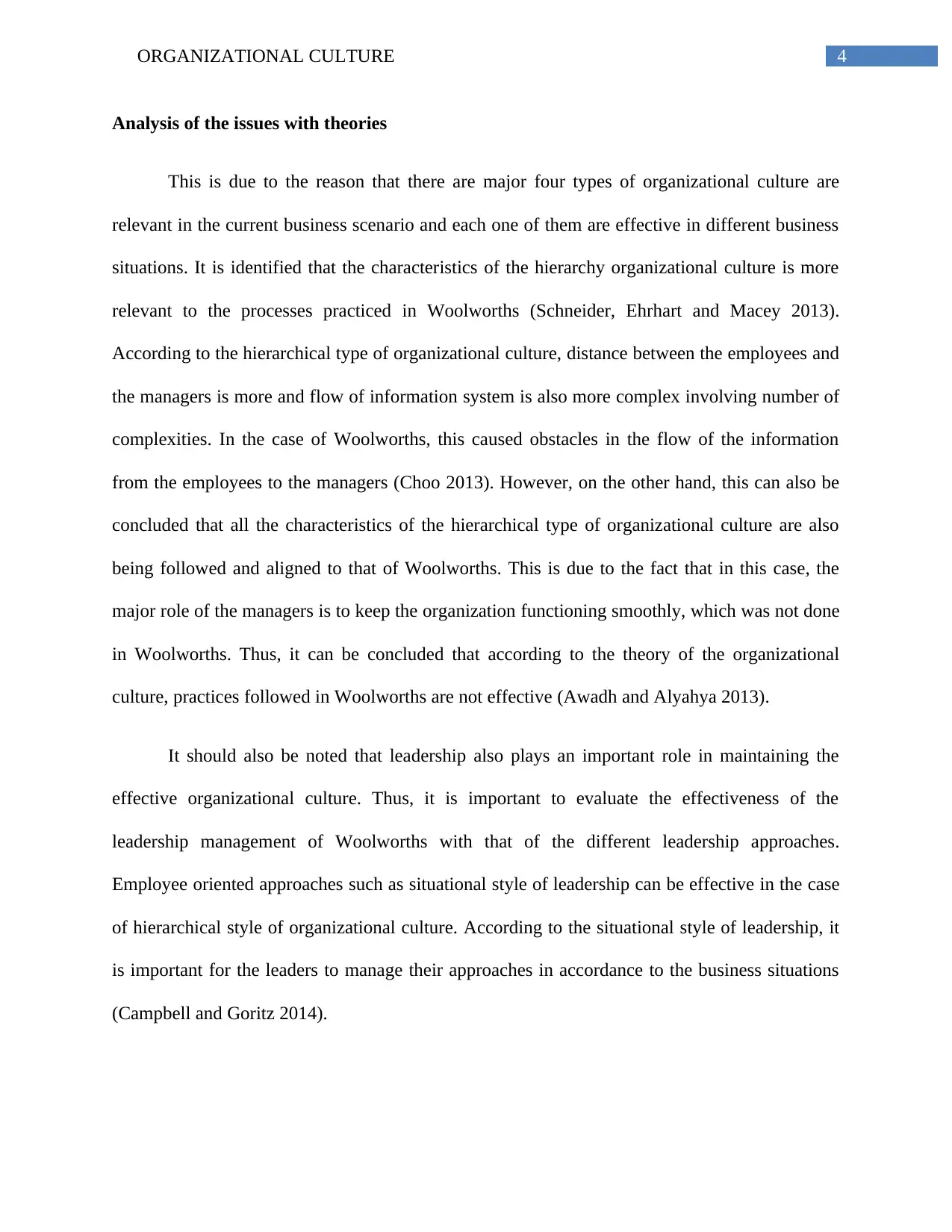
4ORGANIZATIONAL CULTURE
Analysis of the issues with theories
This is due to the reason that there are major four types of organizational culture are
relevant in the current business scenario and each one of them are effective in different business
situations. It is identified that the characteristics of the hierarchy organizational culture is more
relevant to the processes practiced in Woolworths (Schneider, Ehrhart and Macey 2013).
According to the hierarchical type of organizational culture, distance between the employees and
the managers is more and flow of information system is also more complex involving number of
complexities. In the case of Woolworths, this caused obstacles in the flow of the information
from the employees to the managers (Choo 2013). However, on the other hand, this can also be
concluded that all the characteristics of the hierarchical type of organizational culture are also
being followed and aligned to that of Woolworths. This is due to the fact that in this case, the
major role of the managers is to keep the organization functioning smoothly, which was not done
in Woolworths. Thus, it can be concluded that according to the theory of the organizational
culture, practices followed in Woolworths are not effective (Awadh and Alyahya 2013).
It should also be noted that leadership also plays an important role in maintaining the
effective organizational culture. Thus, it is important to evaluate the effectiveness of the
leadership management of Woolworths with that of the different leadership approaches.
Employee oriented approaches such as situational style of leadership can be effective in the case
of hierarchical style of organizational culture. According to the situational style of leadership, it
is important for the leaders to manage their approaches in accordance to the business situations
(Campbell and Goritz 2014).
Analysis of the issues with theories
This is due to the reason that there are major four types of organizational culture are
relevant in the current business scenario and each one of them are effective in different business
situations. It is identified that the characteristics of the hierarchy organizational culture is more
relevant to the processes practiced in Woolworths (Schneider, Ehrhart and Macey 2013).
According to the hierarchical type of organizational culture, distance between the employees and
the managers is more and flow of information system is also more complex involving number of
complexities. In the case of Woolworths, this caused obstacles in the flow of the information
from the employees to the managers (Choo 2013). However, on the other hand, this can also be
concluded that all the characteristics of the hierarchical type of organizational culture are also
being followed and aligned to that of Woolworths. This is due to the fact that in this case, the
major role of the managers is to keep the organization functioning smoothly, which was not done
in Woolworths. Thus, it can be concluded that according to the theory of the organizational
culture, practices followed in Woolworths are not effective (Awadh and Alyahya 2013).
It should also be noted that leadership also plays an important role in maintaining the
effective organizational culture. Thus, it is important to evaluate the effectiveness of the
leadership management of Woolworths with that of the different leadership approaches.
Employee oriented approaches such as situational style of leadership can be effective in the case
of hierarchical style of organizational culture. According to the situational style of leadership, it
is important for the leaders to manage their approaches in accordance to the business situations
(Campbell and Goritz 2014).
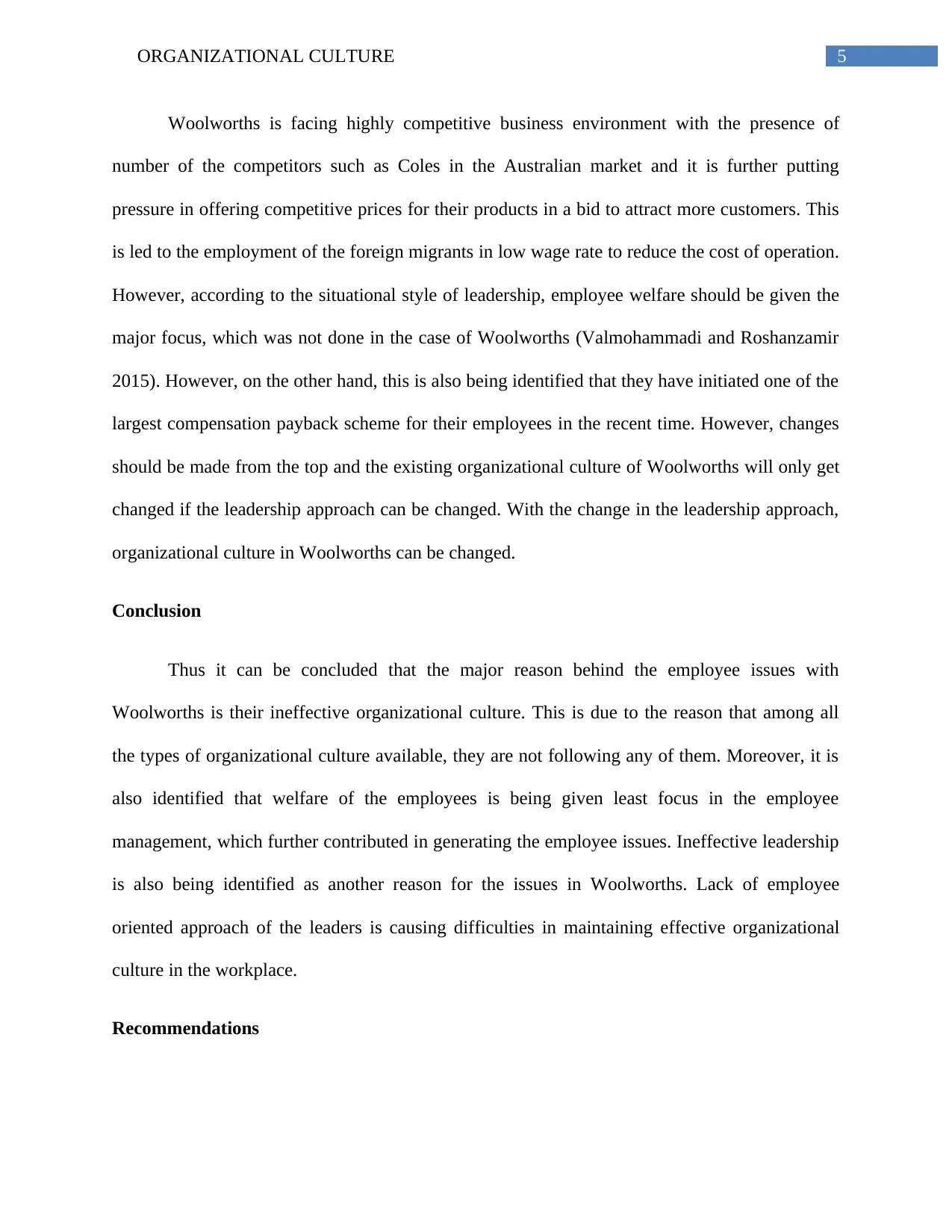
5ORGANIZATIONAL CULTURE
Woolworths is facing highly competitive business environment with the presence of
number of the competitors such as Coles in the Australian market and it is further putting
pressure in offering competitive prices for their products in a bid to attract more customers. This
is led to the employment of the foreign migrants in low wage rate to reduce the cost of operation.
However, according to the situational style of leadership, employee welfare should be given the
major focus, which was not done in the case of Woolworths (Valmohammadi and Roshanzamir
2015). However, on the other hand, this is also being identified that they have initiated one of the
largest compensation payback scheme for their employees in the recent time. However, changes
should be made from the top and the existing organizational culture of Woolworths will only get
changed if the leadership approach can be changed. With the change in the leadership approach,
organizational culture in Woolworths can be changed.
Conclusion
Thus it can be concluded that the major reason behind the employee issues with
Woolworths is their ineffective organizational culture. This is due to the reason that among all
the types of organizational culture available, they are not following any of them. Moreover, it is
also identified that welfare of the employees is being given least focus in the employee
management, which further contributed in generating the employee issues. Ineffective leadership
is also being identified as another reason for the issues in Woolworths. Lack of employee
oriented approach of the leaders is causing difficulties in maintaining effective organizational
culture in the workplace.
Recommendations
Woolworths is facing highly competitive business environment with the presence of
number of the competitors such as Coles in the Australian market and it is further putting
pressure in offering competitive prices for their products in a bid to attract more customers. This
is led to the employment of the foreign migrants in low wage rate to reduce the cost of operation.
However, according to the situational style of leadership, employee welfare should be given the
major focus, which was not done in the case of Woolworths (Valmohammadi and Roshanzamir
2015). However, on the other hand, this is also being identified that they have initiated one of the
largest compensation payback scheme for their employees in the recent time. However, changes
should be made from the top and the existing organizational culture of Woolworths will only get
changed if the leadership approach can be changed. With the change in the leadership approach,
organizational culture in Woolworths can be changed.
Conclusion
Thus it can be concluded that the major reason behind the employee issues with
Woolworths is their ineffective organizational culture. This is due to the reason that among all
the types of organizational culture available, they are not following any of them. Moreover, it is
also identified that welfare of the employees is being given least focus in the employee
management, which further contributed in generating the employee issues. Ineffective leadership
is also being identified as another reason for the issues in Woolworths. Lack of employee
oriented approach of the leaders is causing difficulties in maintaining effective organizational
culture in the workplace.
Recommendations
⊘ This is a preview!⊘
Do you want full access?
Subscribe today to unlock all pages.

Trusted by 1+ million students worldwide
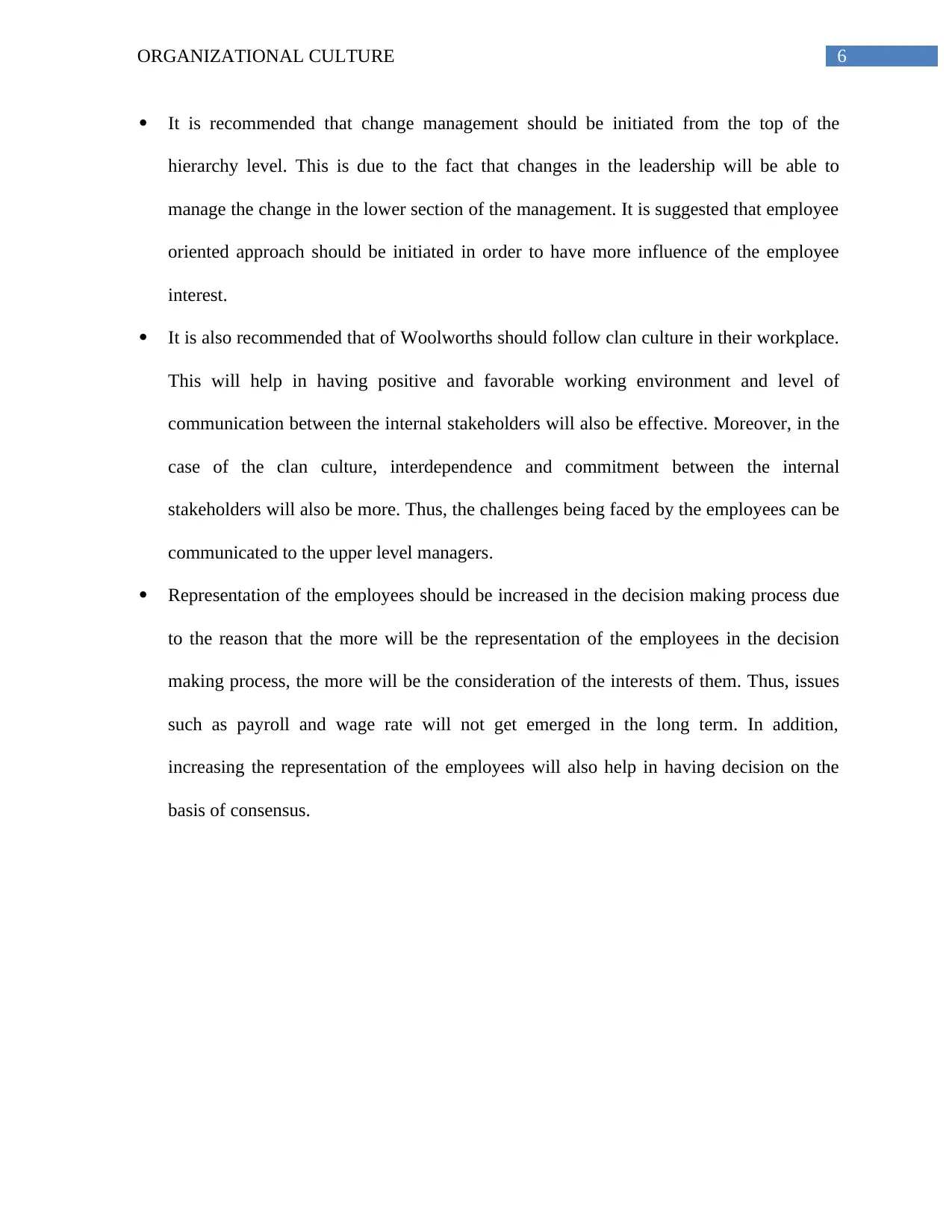
6ORGANIZATIONAL CULTURE
It is recommended that change management should be initiated from the top of the
hierarchy level. This is due to the fact that changes in the leadership will be able to
manage the change in the lower section of the management. It is suggested that employee
oriented approach should be initiated in order to have more influence of the employee
interest.
It is also recommended that of Woolworths should follow clan culture in their workplace.
This will help in having positive and favorable working environment and level of
communication between the internal stakeholders will also be effective. Moreover, in the
case of the clan culture, interdependence and commitment between the internal
stakeholders will also be more. Thus, the challenges being faced by the employees can be
communicated to the upper level managers.
Representation of the employees should be increased in the decision making process due
to the reason that the more will be the representation of the employees in the decision
making process, the more will be the consideration of the interests of them. Thus, issues
such as payroll and wage rate will not get emerged in the long term. In addition,
increasing the representation of the employees will also help in having decision on the
basis of consensus.
It is recommended that change management should be initiated from the top of the
hierarchy level. This is due to the fact that changes in the leadership will be able to
manage the change in the lower section of the management. It is suggested that employee
oriented approach should be initiated in order to have more influence of the employee
interest.
It is also recommended that of Woolworths should follow clan culture in their workplace.
This will help in having positive and favorable working environment and level of
communication between the internal stakeholders will also be effective. Moreover, in the
case of the clan culture, interdependence and commitment between the internal
stakeholders will also be more. Thus, the challenges being faced by the employees can be
communicated to the upper level managers.
Representation of the employees should be increased in the decision making process due
to the reason that the more will be the representation of the employees in the decision
making process, the more will be the consideration of the interests of them. Thus, issues
such as payroll and wage rate will not get emerged in the long term. In addition,
increasing the representation of the employees will also help in having decision on the
basis of consensus.
Paraphrase This Document
Need a fresh take? Get an instant paraphrase of this document with our AI Paraphraser
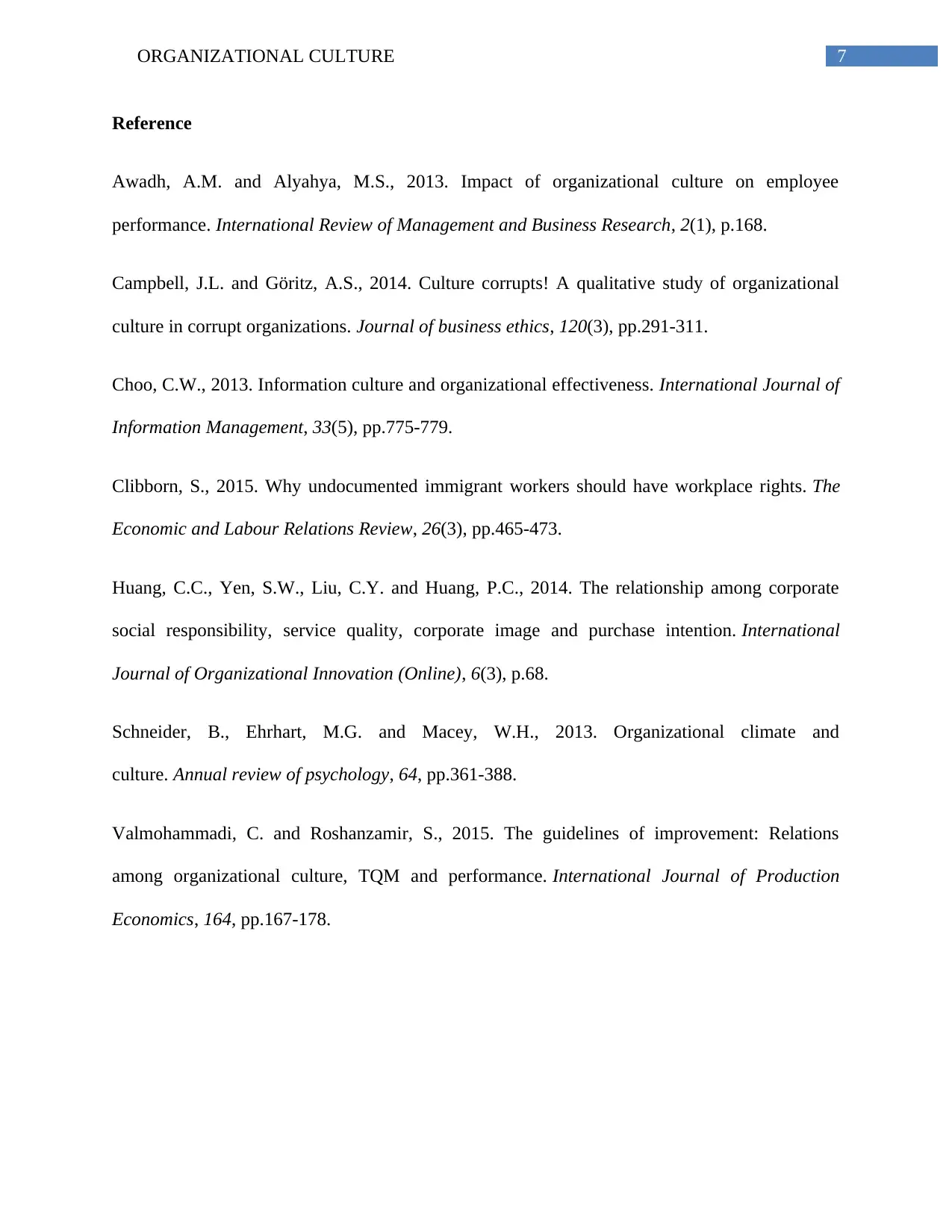
7ORGANIZATIONAL CULTURE
Reference
Awadh, A.M. and Alyahya, M.S., 2013. Impact of organizational culture on employee
performance. International Review of Management and Business Research, 2(1), p.168.
Campbell, J.L. and Göritz, A.S., 2014. Culture corrupts! A qualitative study of organizational
culture in corrupt organizations. Journal of business ethics, 120(3), pp.291-311.
Choo, C.W., 2013. Information culture and organizational effectiveness. International Journal of
Information Management, 33(5), pp.775-779.
Clibborn, S., 2015. Why undocumented immigrant workers should have workplace rights. The
Economic and Labour Relations Review, 26(3), pp.465-473.
Huang, C.C., Yen, S.W., Liu, C.Y. and Huang, P.C., 2014. The relationship among corporate
social responsibility, service quality, corporate image and purchase intention. International
Journal of Organizational Innovation (Online), 6(3), p.68.
Schneider, B., Ehrhart, M.G. and Macey, W.H., 2013. Organizational climate and
culture. Annual review of psychology, 64, pp.361-388.
Valmohammadi, C. and Roshanzamir, S., 2015. The guidelines of improvement: Relations
among organizational culture, TQM and performance. International Journal of Production
Economics, 164, pp.167-178.
Reference
Awadh, A.M. and Alyahya, M.S., 2013. Impact of organizational culture on employee
performance. International Review of Management and Business Research, 2(1), p.168.
Campbell, J.L. and Göritz, A.S., 2014. Culture corrupts! A qualitative study of organizational
culture in corrupt organizations. Journal of business ethics, 120(3), pp.291-311.
Choo, C.W., 2013. Information culture and organizational effectiveness. International Journal of
Information Management, 33(5), pp.775-779.
Clibborn, S., 2015. Why undocumented immigrant workers should have workplace rights. The
Economic and Labour Relations Review, 26(3), pp.465-473.
Huang, C.C., Yen, S.W., Liu, C.Y. and Huang, P.C., 2014. The relationship among corporate
social responsibility, service quality, corporate image and purchase intention. International
Journal of Organizational Innovation (Online), 6(3), p.68.
Schneider, B., Ehrhart, M.G. and Macey, W.H., 2013. Organizational climate and
culture. Annual review of psychology, 64, pp.361-388.
Valmohammadi, C. and Roshanzamir, S., 2015. The guidelines of improvement: Relations
among organizational culture, TQM and performance. International Journal of Production
Economics, 164, pp.167-178.
1 out of 8
Related Documents
Your All-in-One AI-Powered Toolkit for Academic Success.
+13062052269
info@desklib.com
Available 24*7 on WhatsApp / Email
![[object Object]](/_next/static/media/star-bottom.7253800d.svg)
Unlock your academic potential
Copyright © 2020–2025 A2Z Services. All Rights Reserved. Developed and managed by ZUCOL.




